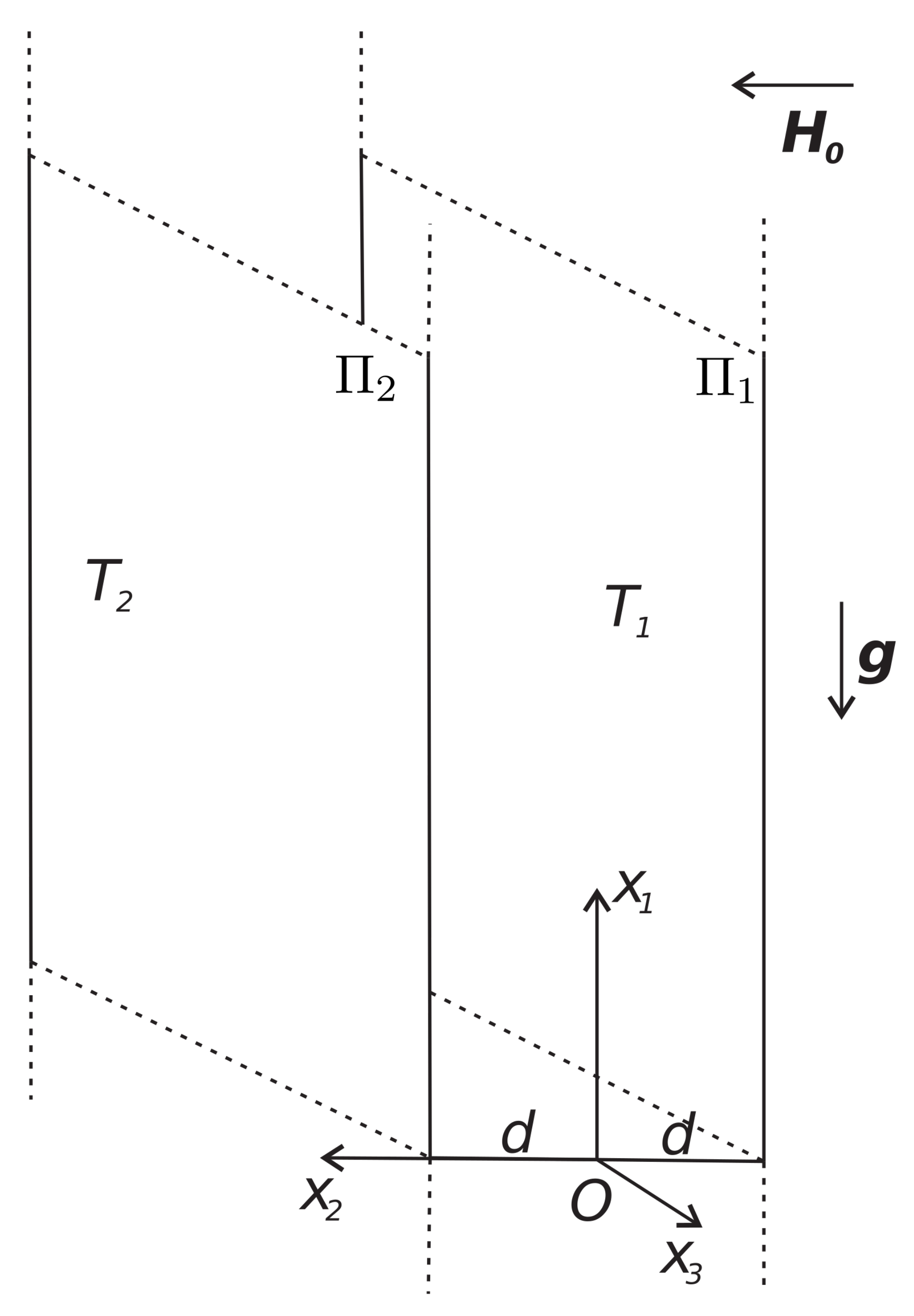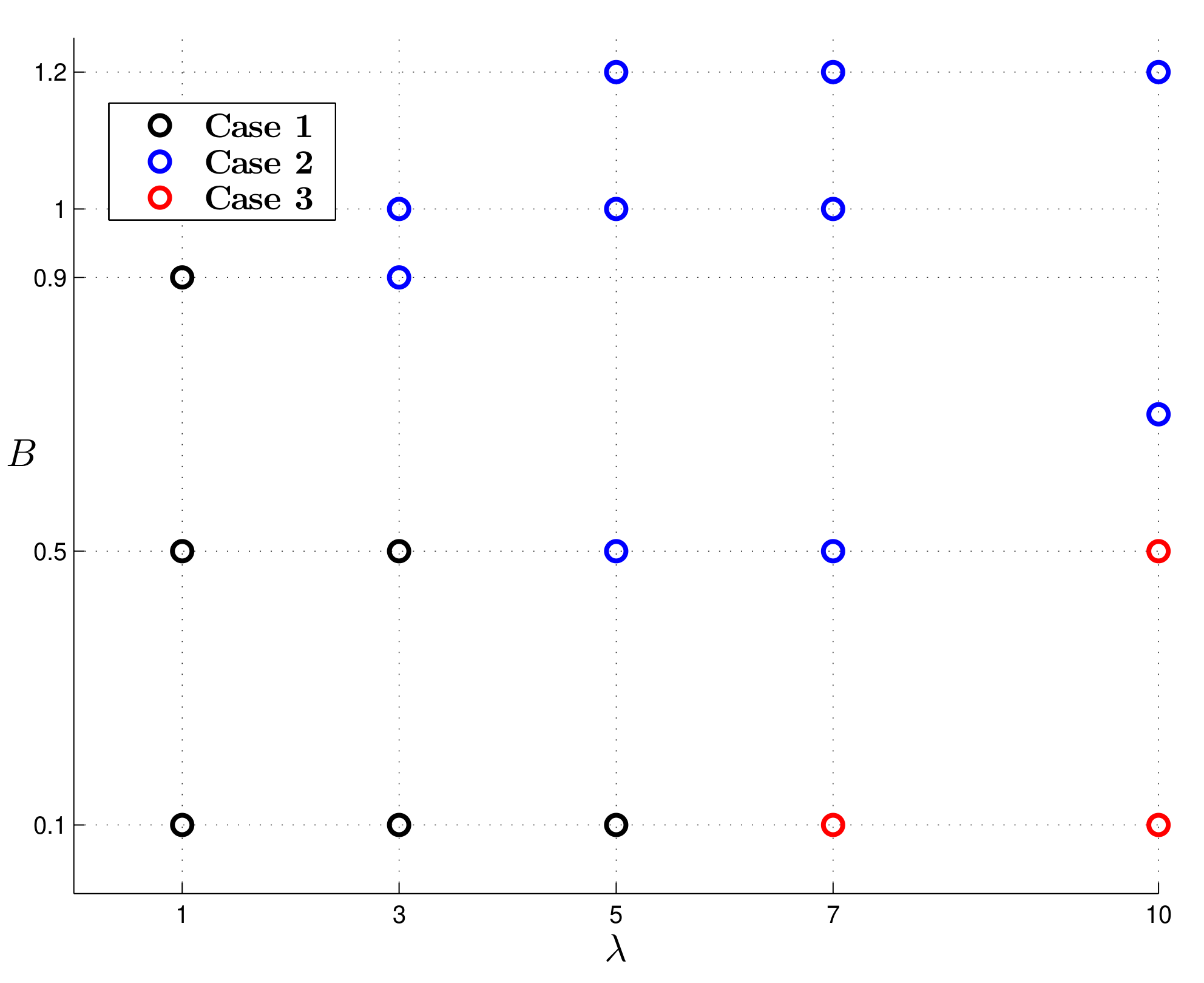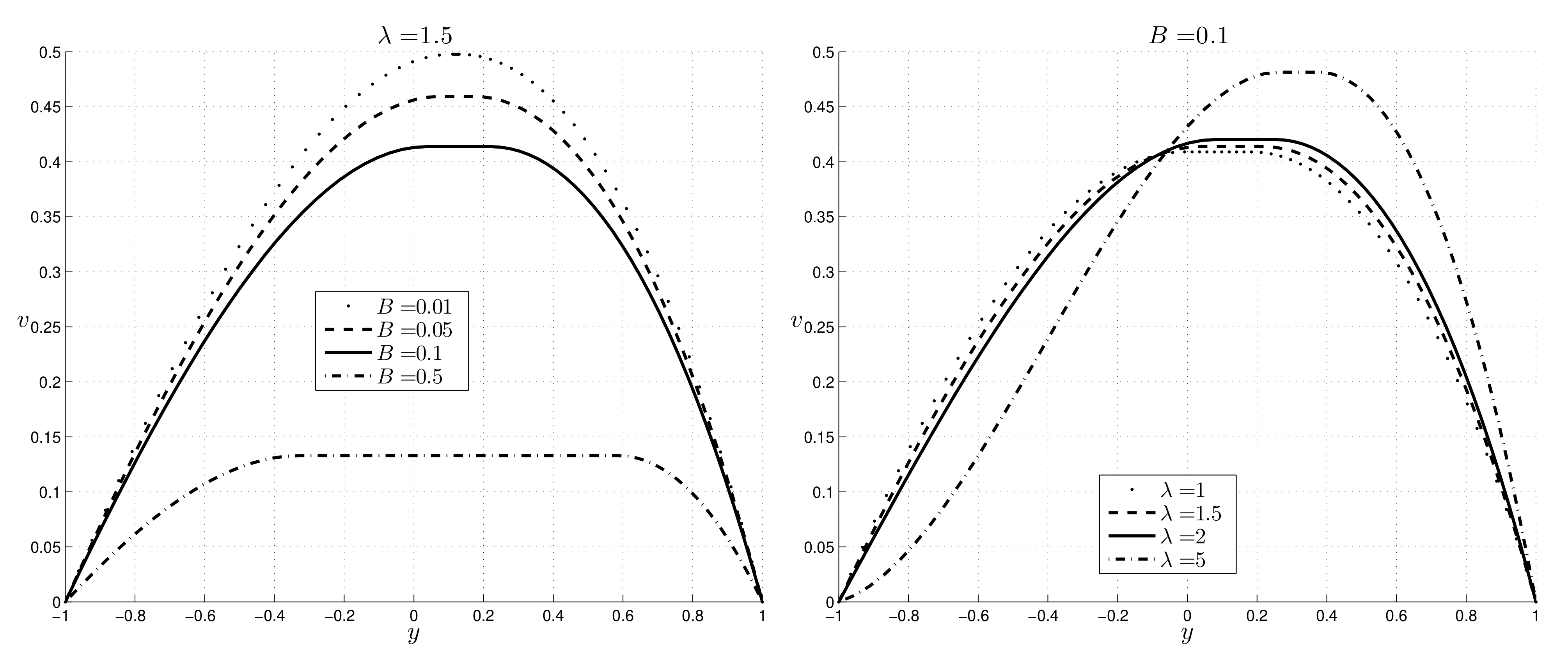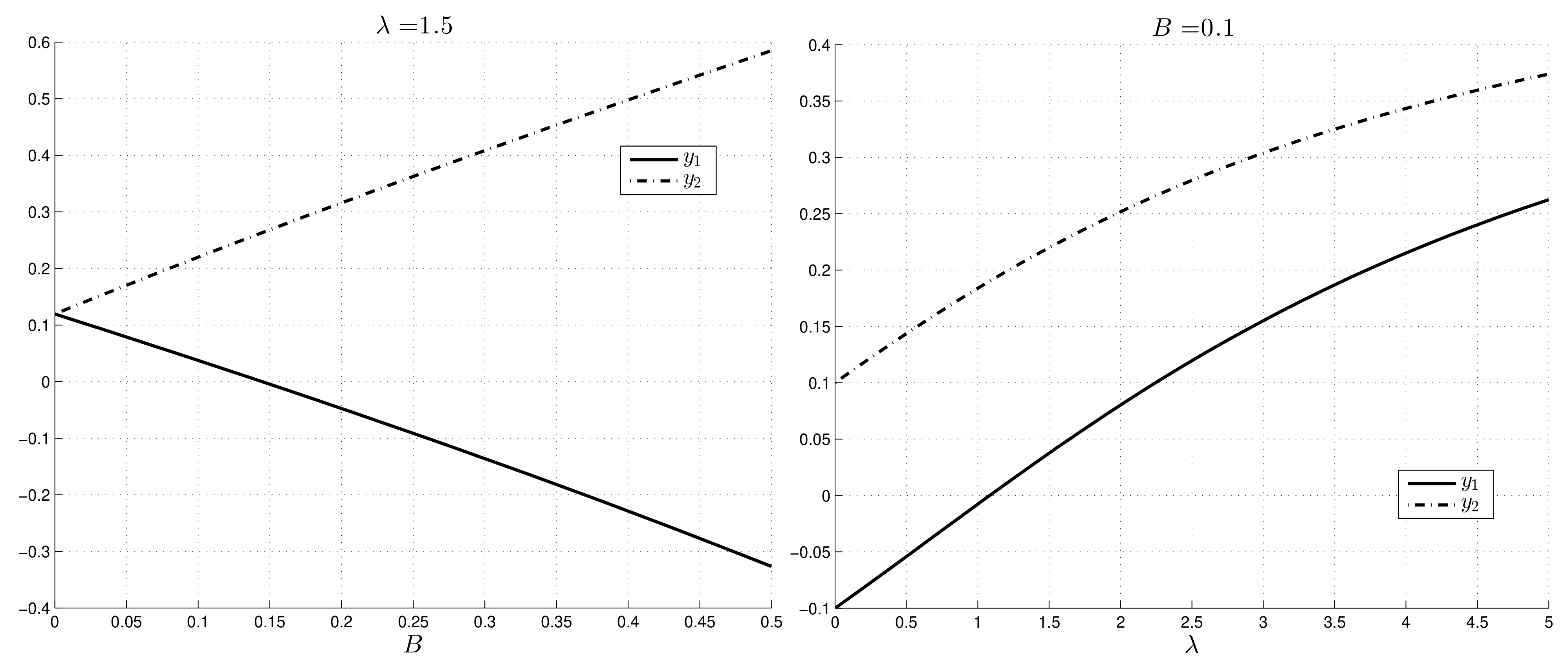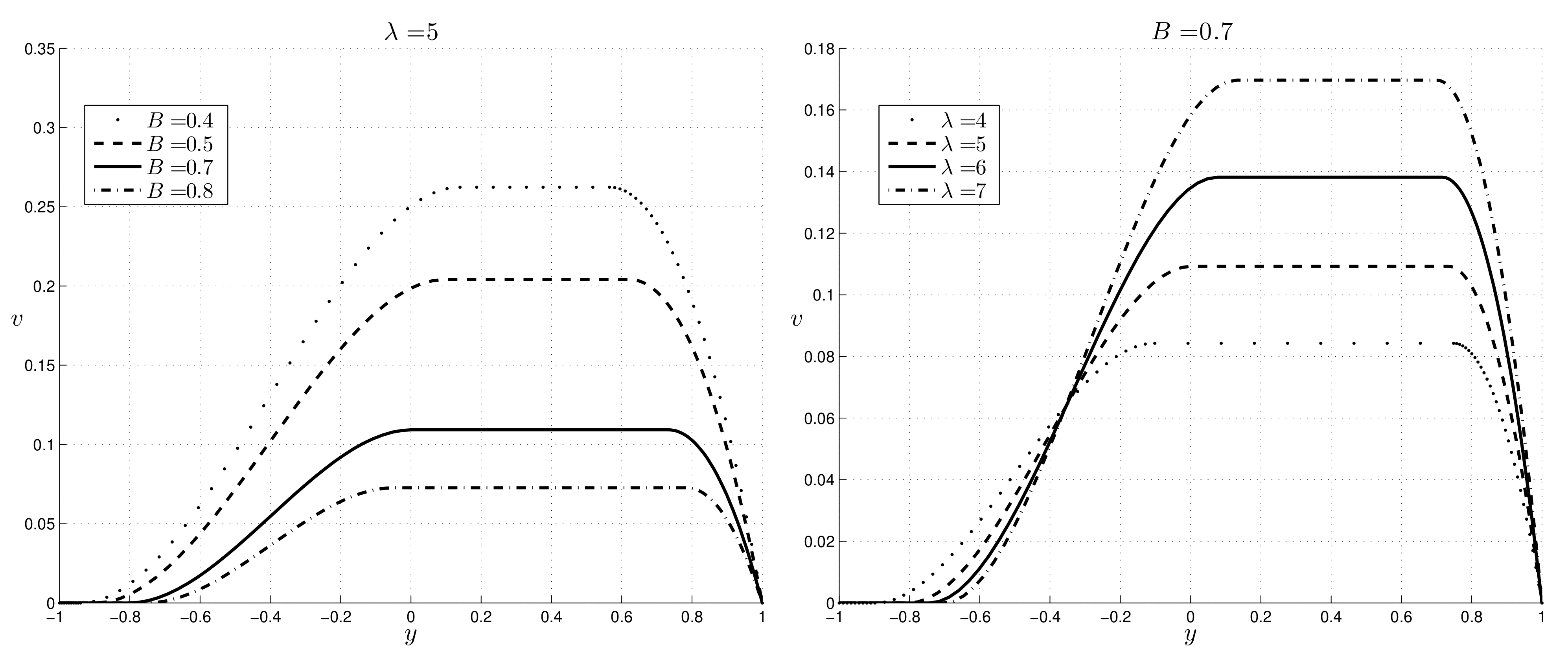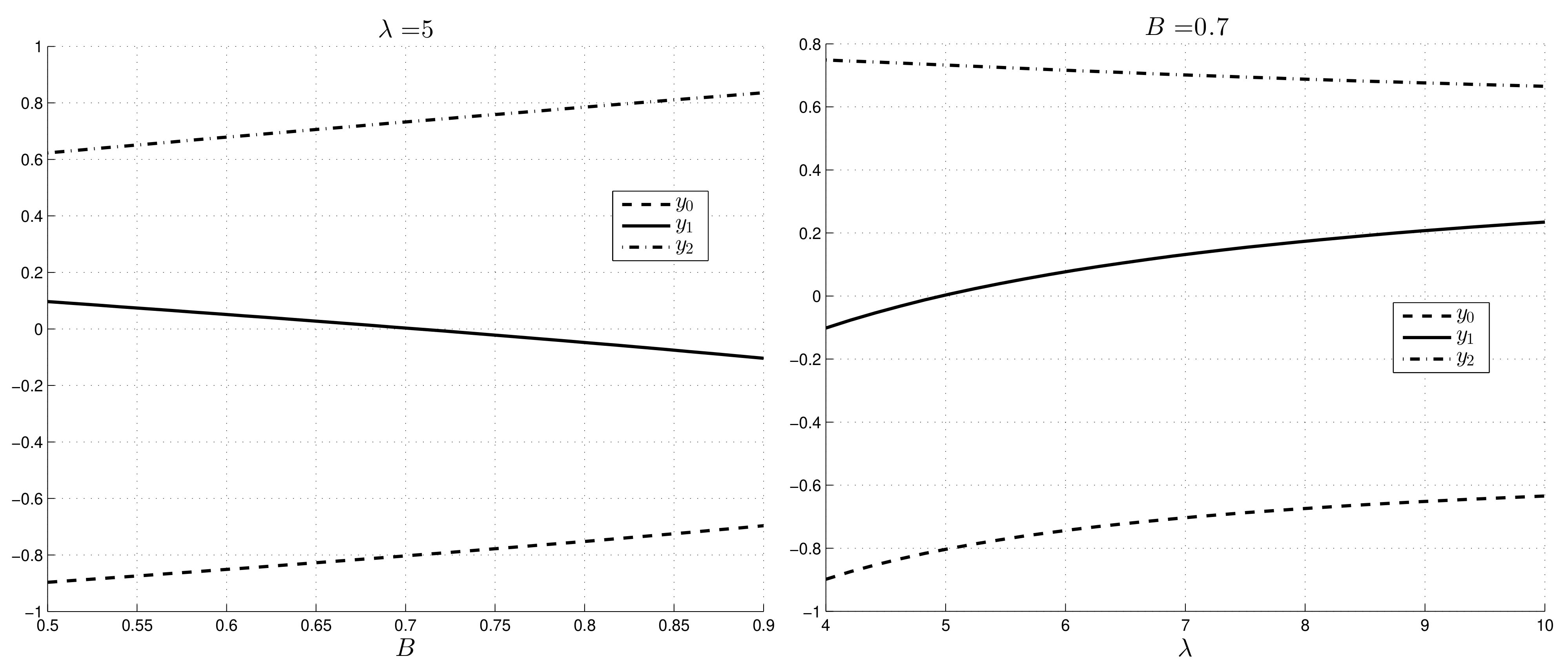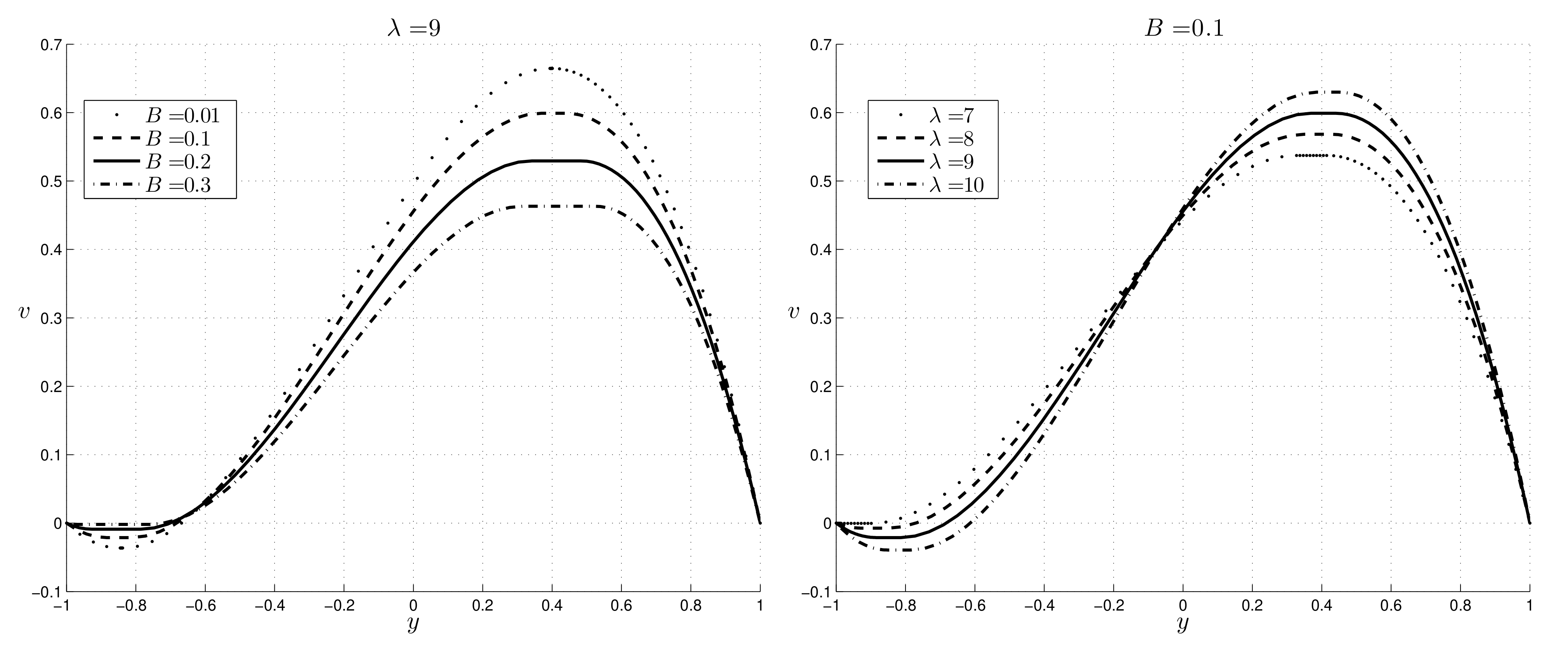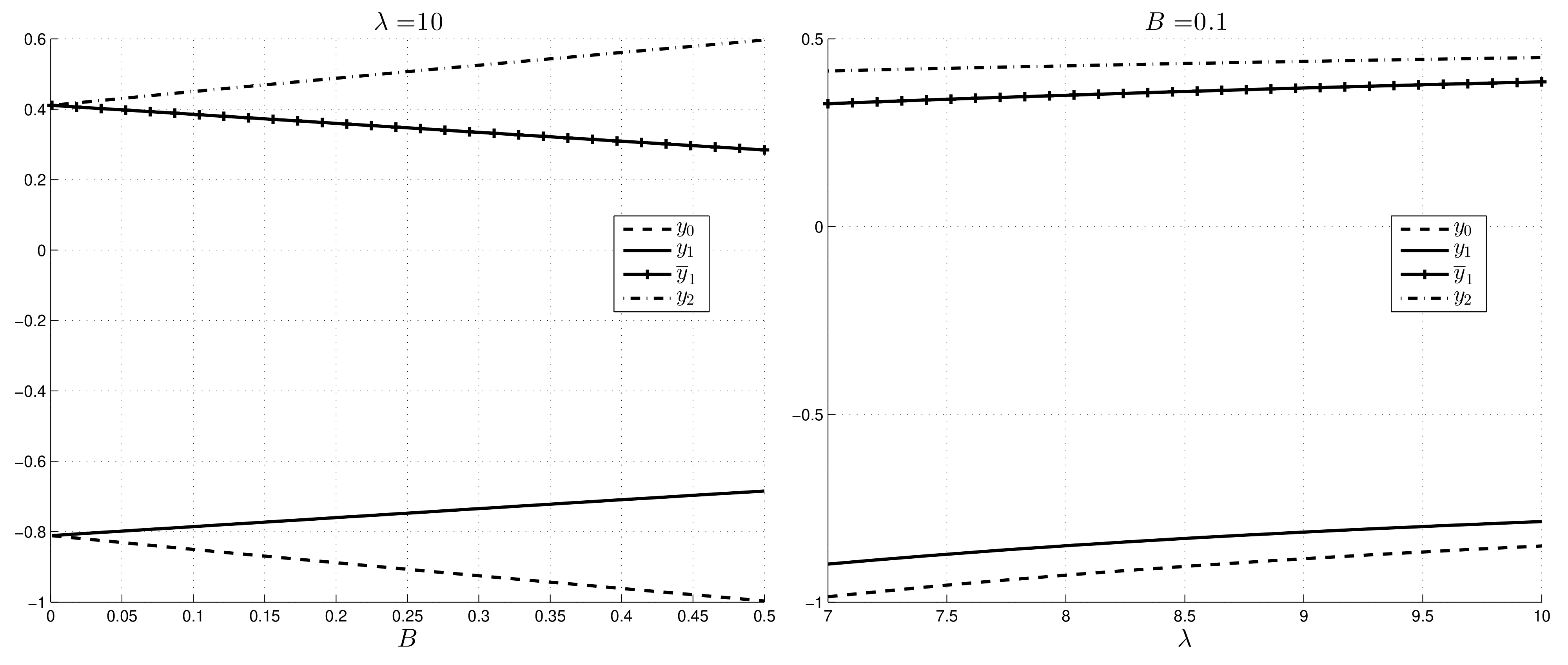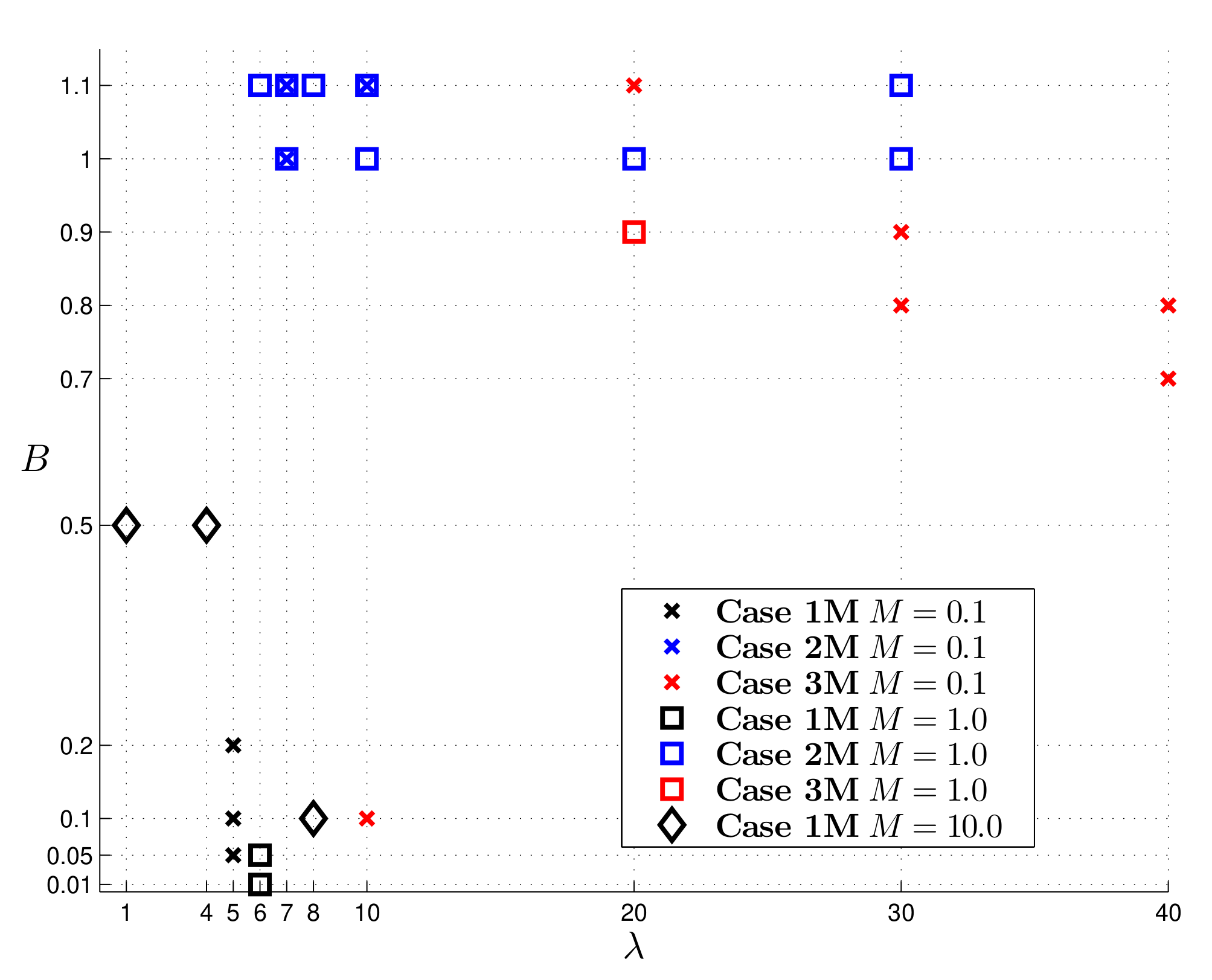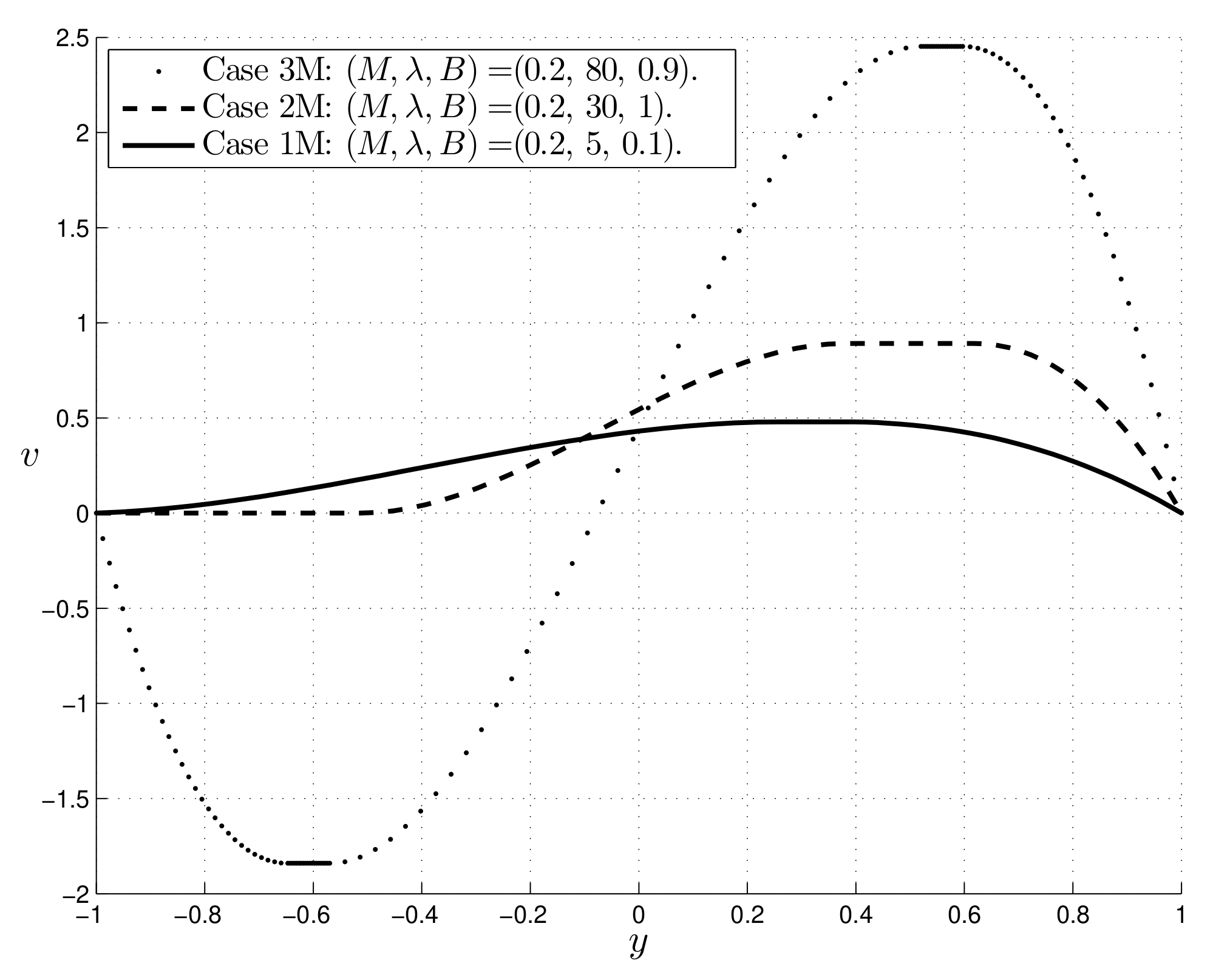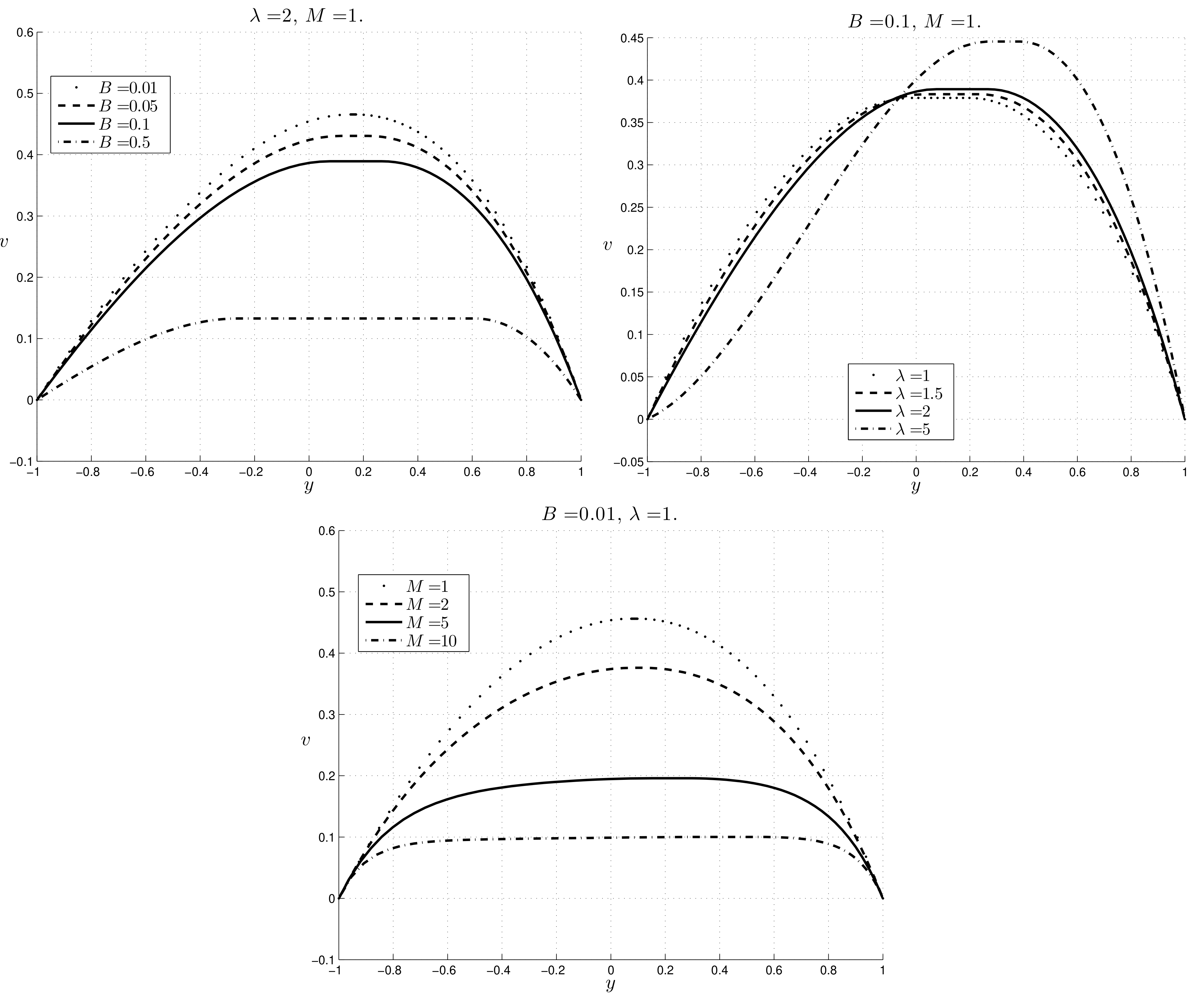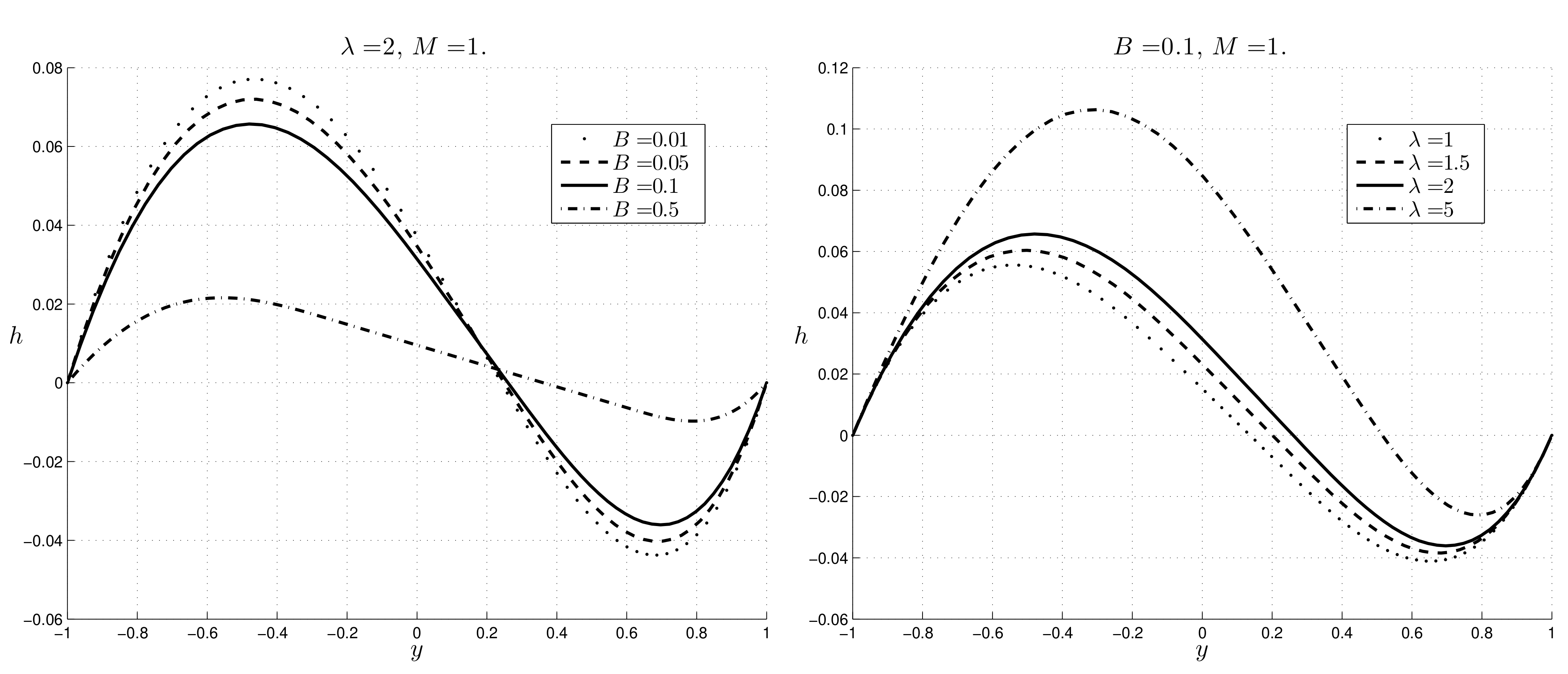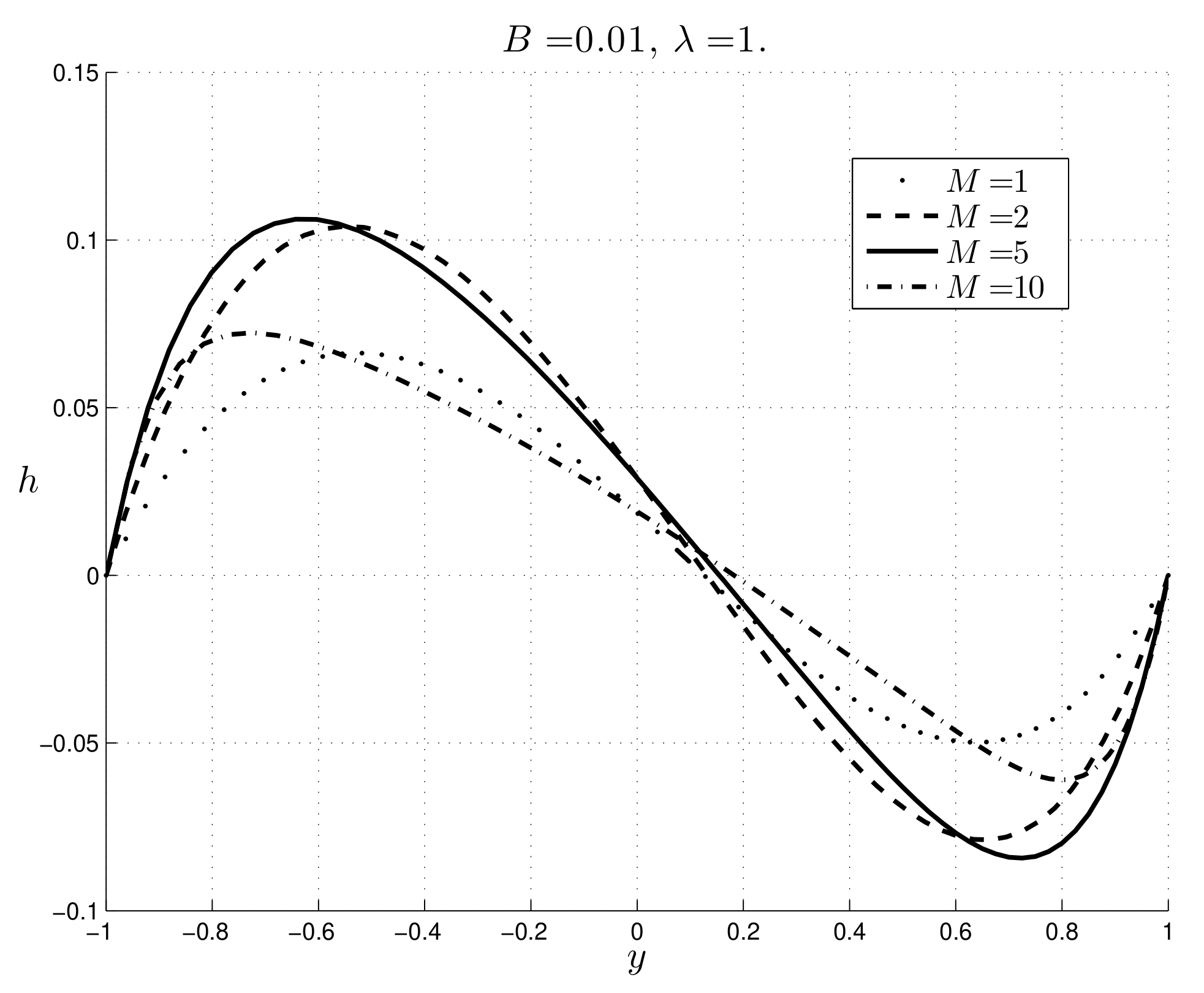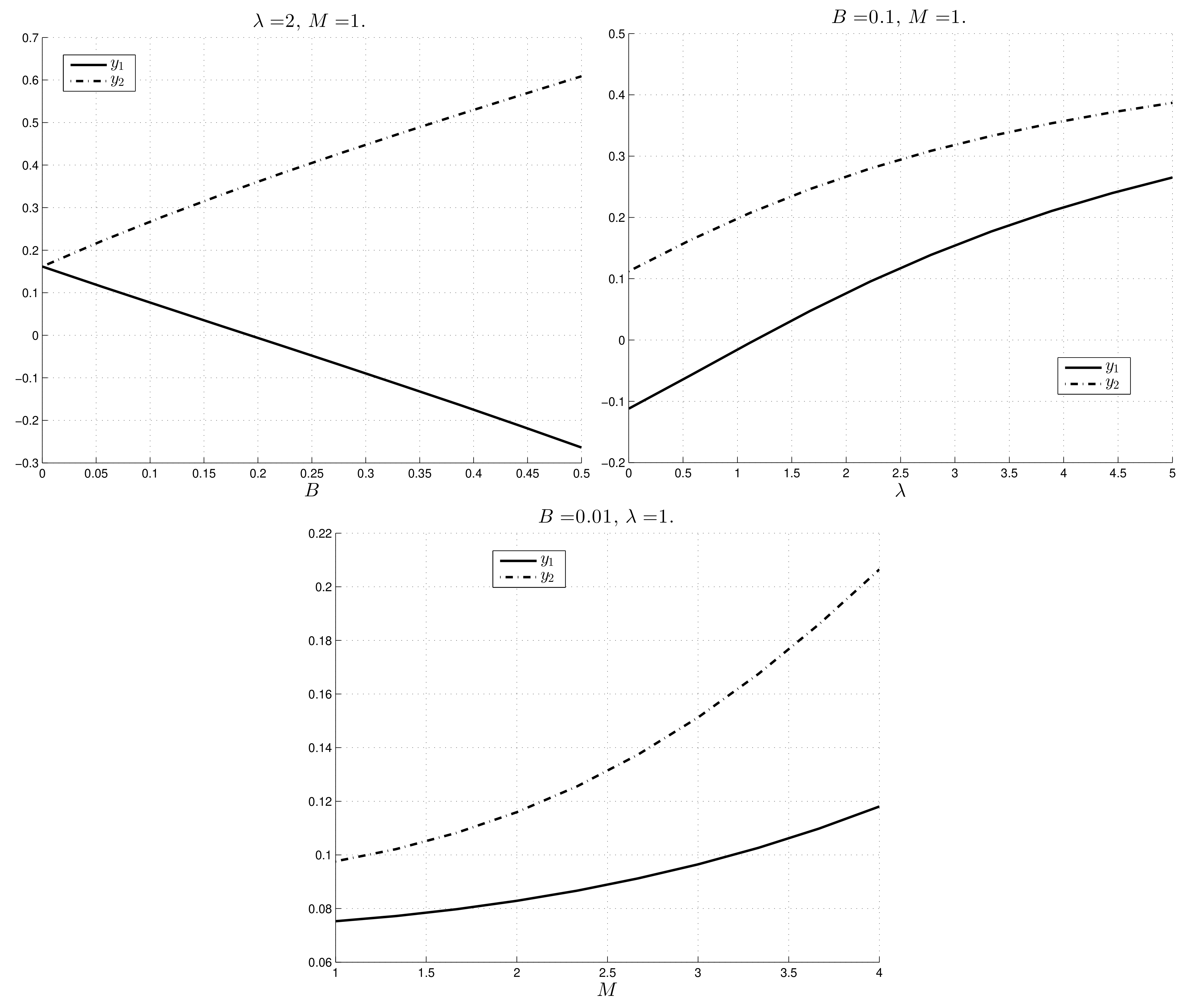1. Introduction
In recent years, magnetohydrodynamics has been the subject of many papers because of its relevant industrial applications. The elements of many magnetohydrodynamic devices are made in the form of long channels filled by rheological fluids. In this paper, we detail our study of the steady flow in the absence or in the presence of a uniform external magnetic field of an electrically conducting Bingham fluid in a vertical channel whose walls are heated at constant different temperatures. We analyze the mixed convection by continuing our previous study [
1] in which we treated the natural convection.
Bingham fluids are non-Newtonian viscoplastic fluids that possess a yield stress below which they behave as rigid solids and as viscous fluids if the shear stress exceeds the yield stress. Therefore, they appear in the channel plug regions, which are a priori unknown and have to be determined as part of the solution of the problem.
We recall that Bingham fluid is one of the simplest models of a viscoplastic fluid [
2]. This kind of fluid modelizes many materials as, for example, muds used in oil extractive industry, cements, ceramics, molten plastics in extrusion processes, and also biological fluids in particular conditions.
Many papers are devoted to the study of Bingham fluids both from a theoretical and a practical point of view. Existence of weak solutions for the system governing the motion is investigated in [
3], studies nonlinear stability of Poiseuille flow in pipes and plane channels in [
4], spatial decay estimates are obtained for the problem of entry flow in a pipe in [
5], and Couette–Poiseuille flow in a porous channel is studied with slip conditions in [
6]. Some papers deal with the convective flow of a Bingham fluid in a vertical channel: the natural convection is studied in [
7] for the Couette–Poiseuille flow and in [
8,
9] for the Poiseuille flow, the effect of internal and external heating on the free convective flow in a porous channel is investigated using Pascal’s piecewise-linear law in [
10], and the mixed convection is analyzed in [
11].
In this research, the flow in the channel is steady and fully-developed, and the walls are vertical and kept at uniform different temperatures. We suppose that the external body forces are due to the gravity and the fluid is slightly compressible so that the Oberbeck–Boussinesq approximation is adopted. Moreover, a constant vertical pressure gradient is applied in order to have mixed convection.
This topic has been studied extensively for Newtonian fluids. A relevant characteristic is that asymmetric wall temperatures produce a skewness in the velocity profile and, if the buoyancy parameter is large enough, the reverse flow can occur near the walls ([
12,
13,
14,
15]). As far as Bingham fluids are concerned, the unique study is due to Patel and Ingham ([
11]), who outline that three different profiles of the velocity are possible if one assumes that the magnitude of the stress at the hot wall is greater than the yield stress.
In this paper, we complete the analysis developed in [
11]. Actually, many considerations in [
11] are only sketched and the limitations to which the Bingham number
B and the buoyancy parameter
must satisfy in order to have plug regions are not obtained. In the second part of our study, we suppose the presence of an external uniform magnetic field orthogonal to the heated walls. Such a magnetic field generates the Lorentz forces that influence the motion as in the well-known Hartmann flow. We notice that literature in this area of research is poor ([
1,
16,
17,
18]), and in most cases, the induced magnetic field is not taken into account.
As previously mentioned, our paper is divided in two parts. The first one (
Section 2 and
Section 3) is devoted to study the mixed convection in the absence of the external magnetic field in detail. We find that the stress depends on an integration constant
that is a priori unknown. Unlike the natural convection in which the problem is symmetric ([
1]), in the mixed convection, we have to distinguish three cases depending on the value of the stress on the coldest wall. We find the analytical expressions of the velocity in the three cases mentioned above and the plug regions are determined together with the value of the constant
. In order to determine the value of
, we match the expressions of the velocity at the interfaces between plug regions and no plug regions. The plug regions depend on the Bingham number
B and on the buoyancy parameter
. We obtain that the first case is possible only if
without a priori restrictions on
, whereas the other two cases are possible only if
while
B may assume also values
. In
Section 3.1, the velocity behavior is analyzed and the plug regions are described. In particular, the velocity decreases as
B increases and the maximum of the velocity increases as
increases. In the third case, the reverse flow phenomenon ([
7,
14,
15]) can occur near the cold wall. This situation happens when the magnitude of the buoyancy parameter is large enough.
The latter part concerns the flow in the presence of external the magnetic field (
Section 4). We point out that we do not neglect the induced magnetic field because we do not impose restrictions on the magnetic Reynolds number. For this reason, it is much more complex to treat the problem because there is another unknown field: the induced magnetic field. In this situation, the significant component of the deviatoric part of the stress tensor depends on the induced magnetic field, which is unknown, and so we cannot obtain the plug regions in terms of the material parameters alone as we did in
Section 3. We find that the presence of the external magnetic field tends to prevent the reverse flow as for a Newtonian fluid. The influence of
B and
on the velocity is analogous to that of
Section 3. As the Hartmann number
M increases, the velocity decreases and the plug region increases its thickness with M. As far as the induced magnetic field
h is concerned, the trend is similar to the Newtonian case ([
14]). In particular,
h is a decreasing function of
B and is a increasing function of
, whereas the modulus of the induced magnetic field is not monotone when
M changes. In
Section 6, we summarize the principal results obtained.
2. The Problem and the Governing Equations
In this section and in the next, we complete the study of the problem considered in [
11] on the fully developed steady flow of a homogeneous Bingham fluid. Actually, many details in [
11] are only sketched and the constraints that must be fulfilled by the Bingham number
B and by the buoyancy parameter
in order to have plug regions are not given. Moreover, we study in the details the influence of
B and
on the velocity profile and on the thickness of the plug regions.
Let us suppose that the motion occurs in the region
between two infinite rigid, fixed, and vertical plates
separated by a distance
(
Figure 1).
We assume that
and
-axis is vertical upward.
The fluid is heat-conducting and the walls
are kept at uniform temperature
with
. Moreover, the fluid is assumed slightly compressible so that, under the Oberbeck–Boussinesq approximation, the governing equations can be written as follows
where
is the velocity,
p is the pressure,
is the deviatoric part of the stress tensor
,
is the constant mass density at the reference temperature
,
is the thermal expansion coefficient,
T is the (absolute) temperature,
is the gravity acceleration, and
b is the thermal diffusivity.
In the energy Equation (
1a), we have neglected the dissipative terms, as is usual in the Oberbeck–Boussinesq approximation.
As known, the deviatoric part of the stress tensor satisfies ([
2]):
In the previous relations, is the stretching tensor, is the dynamic viscosity, and is the yield stress (, positive constants).
We recall that (
2b) means that the fluid behaves like a rigid body (i.e.,
) for small stresses. The regions where the Bingham fluid behaves like a rigid body are called plug regions, and in them, the constitutive equation for the deviatoric stress tensor
is indeterminate.
We assume and , while the second order derivatives of are discontinuous across the boundary of the plug regions.
We study the fully developed flow of the Bingham fluid by searching the velocity and the temperature in the following form
so that
is divergence free.
To (
1), we append the boundary conditions
As far as the temperature is concerned, from (
1c), (
3b), (
4b), (
4c), we obtain
By virtue of (
3) and (
1a), we deduce
where
(
modified pressure) and
is an integration constant.
We recall that in the mixed convection, the flow is induced by the gradient of the temperature together with the gradient of the modified pressure , and so we assume .
At this stage, it is convenient to rescale the variables of the problem in the following way:
where
B is known as the Bingham number and
is the buoyancy parameter. This latter parameter influences in a relevant way the mixed convection in a vertical channel of Newtonian and non-Newtonian fluids because if it is large enough, then the reverse flow phenomenon may occur at cold wall if
or at hot wall if
([
11,
12,
13,
14,
15,
19]).
By using (
7), the temperature assumes the simple expression
as in natural convection ([
1]).
By virtue of (
7), the Equation (
6b) written in dimensionless form becomes
As we will see, the integration constant
plays a fundamental role in studying the problem. Finally, we suppose the constant
in (
6) for the sake of simplicity.
3. Analytical Study of the Flow
By taking into account the previous considerations, the velocity
v satisfies the following equation outside the plug regions:
where the prime
denotes differentiation with respect to
y.
We suppose that near the hot wall (
), the continuum behaves as a viscous fluid so that
. Since for a Newtonian fluid in the mixed convection
, similarly, we assume
By virtue of (
10a) and the continuity of the stress tensor, we have that the continuum behaves as a fluid near the hot wall.
If we denote by
the value of
y closer to 1 such that
, then we have that
v must solve in the interval
the problem
The solution is given by
where
provided
We notice that (
10) assures that
. Simple calculations show that
Now, we study the flow in
. Unlike the natural convection in which the symmetry of the problem imposes that
([
1,
8]), in the mixed convection, there are not a priori restrictions on the value of
, and so we have to distinguish the following cases
- Case 1.
;
- Case 2.
;
- Case 3.
.
Case 1.
From the expression of
given by (
8), we get
Inequalities (
10) and (
15) furnish
As it is immediate to verify
, so that
must satisfy
At this stage, we search if there exists some
such that
is the plug region. Precisely,
must be a solution of the equation
. Of course, we must choose the largest of the two roots of this equation, which is
We notice that inequalities (
17) ensure that
is a real number and that
Then, we solve in
the problem
which furnishes
The constant
has to be determined by requiring
:
Therefore, analogously to the natural convection in
([
1]), this first case occurs if the parameters
and the integration constant
satisfy the following conditions
Finally, we notice that if then .
We now summarize the solution of this case (
Figure 2)
Case 2.
Let us consider now the second case: .
This condition furnishes
that we must associate to
which assures the existence of
.
Since
, there exists a plug region near the wall
. In this region denoted by
, the velocity vanishes and
. This latter equation furnishes two real roots provided
and
is the smallest root given by
Taking into account these results, the condition on
given by (
25) becomes
From (
27), we deduce the following condition on the Bingham number
moreover since
after some calculations we find
Now, we study the flow in
where
is the second root of the equation
. In this interval,
v is the solution of the problem
which gives
Finally, we have to determine
by requiring
, from which follows
Inequalities (
24) and (
27) may be summarized in the form
We then summarize the solution of this case (
Figure 3)
We now discuss the consequences of inequalities (
33), taking into account the four possibilities and inequalities (
28) and (
29).
First, we assume that the max in (
33) is given by
. If the min in (
33) is
, then we must have
If the min in (
33) is
, then, recalling that
, we deduce
Alternatively, we suppose that the max in (
33) is given by
. If the min in (
33) is given by
, then we obtain
Finally, if min in (
33) is given by
, then we have
Moreover, we notice that and if then .
Case 3.
We suppose .
This inequality, together with the condition for the existence of
, implies that
must satisfy
We search now for the smallest
such that
. A simple calculation furnishes
We have that if .
We solve in
the problem
from which we get
The plug region is
with
provided
. Therefore, conditions (
35) must be replaced with
In , the velocity takes the negative constant value , as it is easy to verify.
At this stage, we search the interval
where
and
(
) is such that
. This latter condition gives
The velocity is found solving in the interval
the problem
where
is computed using (
38).
So, in the interval
, the velocity is given by
In order to determine the constant
, we have to solve the equation
where
is furnished by (
12) with
given by (
13): i.e.,
Moreover, we notice that , and if , then .
Finally, we write the solution of this case (
Figure 4)
Remark 1. It is interesting to observe that, since , in case 3, the phenomenon of reverse flow occurs at the cold wall.
Remark 2. Case 1 is possible only if without a priori restrictions on λ, whereas cases 2 and 3 are possible only if while B may also assume values . Thus, we have that the restrictions on B are weaker than those of the isothermal case and the natural convection ([
1,
4,
8]).
Remark 3. We underline that the conditions on B and λ are only necessary if it is essential that there exists solution of (
21)
, or (
33)
, or (
42)
satisfying the restrictions (
17)
, or (
27)
, or (
39a)
, respectively. 3.1. Trend of the Velocity
In this subsection, we analyze the velocity and of the plug regions in the previous three cases.
Table 1 and
Figure 5 show that for every
, only one of the three cases occurs.
The profile of the velocity in
Case 1 is plotted in
Figure 6:
v decreases as
B increases and the maximum of the velocity increases as
increases.
In this case, the plug region is closer to the hot wall; its boundaries are shown in
Figure 7. We have that
decreases with
B and increases with
, while
increases with
B and
. Hence, when
B increases, the thickness of the plug region increases.
Figure 8 shows the trend of
v as the Bingham number
B and the buoyancy parameter
vary in
Case 2: the velocity decreases as
B increases, as in
Case 1.
In
Case 2, we have two plug regions (
Figure 9): one attached to the cold wall (
) and one closer to the hot wall (
).
We have that increases with B and such that the thickness of the plug region increases with these two parameters. Furthermore, we see that the thickness of the plug region increases with B and decreases with .
Finally, the behavior of the velocity in
Case 3 is shown in
Figure 10, which underlines that, in this case, the reverse flow phenomenon can occur near the cold wall. This phenomenon has been studied in other physical situations (see, for example, [
7,
14,
15]). This situation occurs when the magnitude of the buoyancy parameter
is large enough (
). We notice that the reverse flow occurs for a Bingham fluid if
takes values greater than those concerning Newtonian fluids for which the critical value of
is 6 ([
15]). This fact is physically reasonable.
We recall that now we have two plug regions: the thickness of
and
increases with
B, while slightly decreases with
(
Figure 11).
4. Hartmann Flow with Mixed Convection
In this section, we assume that the Bingham fluid filling the channel is electrically conducting, in the regions outside there is a vacuum, and the walls are nonelectrically conducting.
An external uniform magnetic field normal to planes () is applied.
We search the magnetic field
in the form:
so that
is divergence free.
The equations governing the motion now are
where
are the magnetic permeability, magnetic diffusivity respectively (positive constants).
Boundary conditions for the induced magnetic field
are
As in the previous section, we write the problem in dimensionless form by adding to (
7) relation giving the rescaled induced magnetic field
By virtue of (
3), (
44), and (
45a), we deduce
where
is the modified pressure,
and
is an integration constant.
Using (
7) and (
47) and introducing the Hartmann number
M given by
we have that the only significant component of
is
Then, outside the plug regions, we have the system
while the dimesionless temperature
is again given by
In order to study the flow, we adopt arguments and procedures analogous to those used in the absence of magnetic field. However, as it is seen from (
49), now
depends on
h which is unknown so that we cannot obtain the explicit expressions of the boundaries of the plug regions in terms of
as in
Section 3. For this reason, it is not possible to find a priori restrictions on the buoyancy parameter
.
As in the previous section, we assume
so that from (
46) and (
49), we obtain again condition (
10b) on the integration constant
.
The hypothesis on assures that near the hot wall , there is a region where the continuum behaves as a fluid.
We denote by
this region with
such that
. Then, we have to solve in this interval the system
with the boundary conditions
The solution is given by
where the constants
depend on
, which, for the moment, are unknown. The expressions of
are given in the
Appendix A.
In order to study the flow in , we have to distinguish the same three cases examined in the absence of the magnetic field.
Case 1M:
This condition together (
10b) furnishes
Now, we search
such that
and in
the continuum behaves as a fluid. Therefore, in this interval, we have to solve the system
with the boundary conditions
The solution is
where the constants
are given in the
Appendix A and they depend on
which for the moment are unknown.
Unlike what happens in the absence of the magnetic field,
and
cannot be determined explicitly as function of
(see (
13) and (
18)) so that we have three unknowns
that we can determine by means of the following arguments.
First of all, we have that
is a plug region so that
Moreover, also in this region Equation (
50b) holds; hence,
from which
. Then the induced magnetic field in the plug region is linear. Precisely, we have
Finally, since
in
, then
Taking into account (
57)–(
59), we have that
are determined by solving the system
We now summarize the solution of this case (
Figure 2)
Case 2M:
This condition on
furnishes again (
24). Since inequality (
10b) holds, we have to distinguish two cases:
Since
, there is a plug region near the cold wall. We denote by
this region where
;
is the smallest solution of the equation
, i.e.,
As far as the expression of the induced magnetic field is concerned, from
we deduce easily
Of course, and as we have explained in the Case 1.
Now, we suppose
. By virtue of the continuity of
v and taking into account that
in
we search
such that
in
. As in the
Section 2 we have that
is solution of the equation
.
Therefore, we have to solve the system (
54) with the boundary conditions
The solution is given by
where the constants appearing in the solution have the expressions given in (
A3).
Finally, in the velocity is constant, i.e., and the induced magnetic field is linear and given by .
At this stage, we must determine
by means of the system
where
is given in (
66),
and
are obtained from (
67b) and (
52b). If we explicit Equation (
68), then we get
We now summarize the solution of this case (
Figure 3)
Case 3M:
In this case, the condition on
furnishes
Now, we study the flow in
; first of all we search the smallest
such that
, i.e.,
We have to solve in
the system (
50) with the boundary conditions
whose solution is
where
are given in the
Appendix A.
Now, we search the plug region
where
satisfies the equation
, i.e.,
The next step is to search the interval where and is solution of .
The velocity and the induced magnetic field satisfy in
the system (
54) with the boundary conditions
Hence
are given by (
67) with the substitution of the constants
with
respectively. In the
Appendix A, we write the expressions of the arbitrary constants.
In
there is another plug region where
To conclude, we must determine that are unknown.
By proceeding as previously, we have to solve the system
After some calculations the previous system becomes
Finally, the solution of this case is given by (
Figure 4)
Remark 4. Taking into account the Maxwell equations, we have that to the magnetic field an electric field is associated given by where is a constant, as a consequence of (
50b)
. The value taken by depends on the case considered. Since in the most of papers concerning MHD flows, the induced magnetic fied is neglected, the presence of a uniform electric field orthogonal to the flow and to the magnetic field is not highlighted.
Finally, outside the walls, where we assume that there is a vacuum, the electromagnetic field is given by
Remark 5. We furnish some physical characteristics of the flow in the three cases. These features do not depend on the presence of the external magnetic field.
The Nusselt number at the walls is where are the heat transfer coefficients of the walls.
The heat flux vector, which is related to the Nusselt number, is constant in the channel and is given by
This expression is physically quite reasonable because the heat transfer occurs from the hot wall to the cold one.
The skin frictions
at both walls are given by
